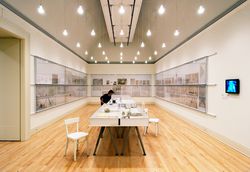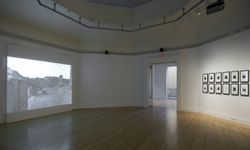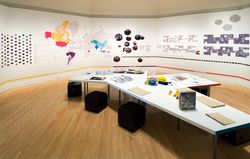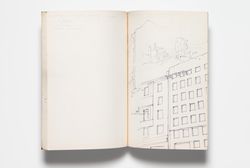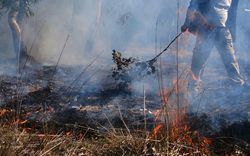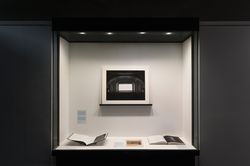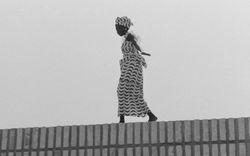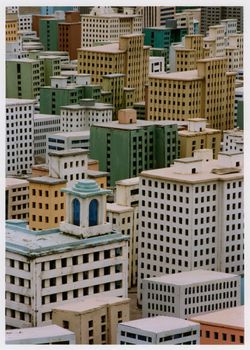archives
Level of archival description:
Fonds
Kenneth Frampton fonds
AP197
Synopsis:
The Kenneth Frampton fonds, 1958-2016, documents the professional career of Kenneth Frampton – British architect, historian, theorist, and Ware professor of Architecture at the Graduate School of Architecture, Planning and Preservation (GSAPP) at Columbia University. Materials in the fonds consist of approximately 28.37 l.m. of textual records, 3966 photographs and prints, 3168 postcards, 2733 slides, 824 drawings (including reprographic copies), 470 negatives, 151 35 mm negatives, 105 posters, 30 objects, 23 audio cassettes, 18 VHS tapes, 15 transparencies, 3 tape reels, 2 microfilms, and 2 vinyl records.
1958-2016
Kenneth Frampton fonds
Actions:
AP197
Synopsis:
The Kenneth Frampton fonds, 1958-2016, documents the professional career of Kenneth Frampton – British architect, historian, theorist, and Ware professor of Architecture at the Graduate School of Architecture, Planning and Preservation (GSAPP) at Columbia University. Materials in the fonds consist of approximately 28.37 l.m. of textual records, 3966 photographs and prints, 3168 postcards, 2733 slides, 824 drawings (including reprographic copies), 470 negatives, 151 35 mm negatives, 105 posters, 30 objects, 23 audio cassettes, 18 VHS tapes, 15 transparencies, 3 tape reels, 2 microfilms, and 2 vinyl records.
archives
Level of archival description:
Fonds
1958-2016
Starting from diverse premises and points of view, Cedric Price, Aldo Rossi, James Stirling, and Gordon Matta-Clark each engaged in a radical rethinking of the status, history, and purpose of architecture. out of the box: price rossi stirling + matta-clark brings the ideas of these four pivotal figures of the 1970s into dialogue through a group of archives that recently(...)
Main galleries
23 October 2003 to 6 September 2004
out of the box: price rossi stirling + matta-clark
Actions:
Description:
Starting from diverse premises and points of view, Cedric Price, Aldo Rossi, James Stirling, and Gordon Matta-Clark each engaged in a radical rethinking of the status, history, and purpose of architecture. out of the box: price rossi stirling + matta-clark brings the ideas of these four pivotal figures of the 1970s into dialogue through a group of archives that recently(...)
Main galleries
British conceptual artist Victor Burgin has been influential both as an artist and as a theorist of the still and moving image. Commissioned by the CCA, Voyage to Italy comprises two series of black and white photographs and an evocative video that engage the timeless beauty and lasting resonance of a nineteenth-century Carlo Fratacci photograph of Pompeii in the CCA(...)
Octagonal gallery
7 December 2006 to 25 March 2007
Victor Burgin: Voyage to Italy
Actions:
Description:
British conceptual artist Victor Burgin has been influential both as an artist and as a theorist of the still and moving image. Commissioned by the CCA, Voyage to Italy comprises two series of black and white photographs and an evocative video that engage the timeless beauty and lasting resonance of a nineteenth-century Carlo Fratacci photograph of Pompeii in the CCA(...)
Octagonal gallery
Inside the Sponge
Simmons Hall is an award-winning university dormitory designed by architect Steven Holl on the Massachusetts Institute of Technology (MIT) campus in Cambridge. Inspired by the sea sponge and the concept of porosity, the building is radical in structure and ambitious in its program to encourage social interaction. Inside the Sponge is an investigation of Simmons Hall from(...)
Octagonal gallery
10 August 2006 to 19 November 2006
Inside the Sponge
Actions:
Description:
Simmons Hall is an award-winning university dormitory designed by architect Steven Holl on the Massachusetts Institute of Technology (MIT) campus in Cambridge. Inspired by the sea sponge and the concept of porosity, the building is radical in structure and ambitious in its program to encourage social interaction. Inside the Sponge is an investigation of Simmons Hall from(...)
Octagonal gallery
Visiting Scholar Seminar: Gregorio Carboni Maestri
Portugal: Architecture, Tendenza, Revolution
Visiting Scholar Gregorio Carboni Maestri presents his research. From the 1930s to the late 1980s, Portuguese architecture was formed through a frustrated relationship with modernity and through a crucial dialogue with Italy. This talk addresses how Portuguese architecture observed and reacted to Italian models such as rationalism in the 1930s, postwar neorealism, and(...)
Shaughnessy House Keyword(s):
Gregorio Carboni Maestri, Visiting Scholar, Portugal, Tendenza
3 August 2017, 6pm
Visiting Scholar Seminar: Gregorio Carboni Maestri
Actions:
Description:
Visiting Scholar Gregorio Carboni Maestri presents his research. From the 1930s to the late 1980s, Portuguese architecture was formed through a frustrated relationship with modernity and through a crucial dialogue with Italy. This talk addresses how Portuguese architecture observed and reacted to Italian models such as rationalism in the 1930s, postwar neorealism, and(...)
Shaughnessy House Keyword(s):
Gregorio Carboni Maestri, Visiting Scholar, Portugal, Tendenza
articles
Counter-Narratives of Care
Figuring Territory
14 November 2022
Counter-Narratives of Care
Michaela Prunotto in dialogue with Loving Country. Photo essay by Vicky Shukuroglou
Actions:
Figuring Territory
Mirrors / Miroirs
Mirrors/ Miroirs is conceived through an indirect dialogue with the exhibition Besides, History: Go Hasegawa, Kersten Geers, David Van Severen, a project rooted in the shared references and resonances between the work of two contemporary practices in the presence of history. If Besides, History is premised on impressions of one office’s work registered through(...)
Hall cases
22 June 2017 to 14 January 2018
Mirrors / Miroirs
Actions:
Description:
Mirrors/ Miroirs is conceived through an indirect dialogue with the exhibition Besides, History: Go Hasegawa, Kersten Geers, David Van Severen, a project rooted in the shared references and resonances between the work of two contemporary practices in the presence of history. If Besides, History is premised on impressions of one office’s work registered through(...)
Hall cases
Project
AP148.S1.1970.PR02
Description:
The project series documents Poli's work on the Interplanetary Architecture project, which was also made into a film by Superstudio directed by Alessandro Poli (the film is not included in the fonds). The project reflects Poli's deep fascination with the moon landing in 1969. Poli uses this major media event as a catalyst for thinking about a new approach to architecture and tools for design, including the idea that film and the movie camera should become part of the toolset. The project also seems to be in some way a response to Epoch magazine's challenge for a "Primo concorso di architettura nello spazio" (the first architectural competition in space), and includes much imagery and textual references to a new road or architectural links between the earth and other planets, including an earth moon highway. In his storyboard, Poli also makes reference to his earlier Piper project, and some imagery features wheels and an amusement park. The Interplanetary Architecture project was exhibited by Superstudio in Rome in 1972 and featured in "Casabella" magazine in April 1972 (no. 364). The project was also featured in the 2010 CCA exhibition "Other Space Odysseys". In the accompanying CCA publication, Poli describes this project as "a voyage off earthbound routes in quest of architecture unfettered by the urban nightmare, by induced needs or by planning as the only tool for regulating and solving the world's problems" (Poli quoted in Borasi and Zardini, 2010, 110). Poli's work on this project is deeply tied to the Zeno project, which was also featured in this exhibition and is included in this fonds (see AP148.S1.1972.PR01). For the Zeno project, Poli envisioned a dialogue between astronaut Buzz Aldrin and an Italian peasant, Zeno of Riparbella. Poli felt that these two shared a similarity in that both their homes were isolated capsules, one that provided a lens from which to see the rest of the world and understand their place in it. The material in the series includes numerous photomontages and collages of astronauts in space, as well as drawings of plantery shapes and structures. There are also texts, some of which include calculations of distances and diameters of planets, as well as notebooks and sketchbooks, many of which Poli included in a folder he entitled "Storyboard." The series also includes an unsent letter from Poli to Adolfo Natalini which describes how, after the moon landing, everything - the planet, the moon, the stars - is architecture, and that this will necessitate the need for new design tools, such as the movie camera. Some works are signed Alessandro Poli-Superstudio. Source cited: Giovanna Borasi and Mirko Zardini, eds., Other Space Odysseys, Montreal and Baden: Canadian Centre for Architecture/Lars Müller Publishers, 2010.
1969-1971
Architettura Interplanetaria [Interplanetary Architecture] (1970-1971)
Actions:
AP148.S1.1970.PR02
Description:
The project series documents Poli's work on the Interplanetary Architecture project, which was also made into a film by Superstudio directed by Alessandro Poli (the film is not included in the fonds). The project reflects Poli's deep fascination with the moon landing in 1969. Poli uses this major media event as a catalyst for thinking about a new approach to architecture and tools for design, including the idea that film and the movie camera should become part of the toolset. The project also seems to be in some way a response to Epoch magazine's challenge for a "Primo concorso di architettura nello spazio" (the first architectural competition in space), and includes much imagery and textual references to a new road or architectural links between the earth and other planets, including an earth moon highway. In his storyboard, Poli also makes reference to his earlier Piper project, and some imagery features wheels and an amusement park. The Interplanetary Architecture project was exhibited by Superstudio in Rome in 1972 and featured in "Casabella" magazine in April 1972 (no. 364). The project was also featured in the 2010 CCA exhibition "Other Space Odysseys". In the accompanying CCA publication, Poli describes this project as "a voyage off earthbound routes in quest of architecture unfettered by the urban nightmare, by induced needs or by planning as the only tool for regulating and solving the world's problems" (Poli quoted in Borasi and Zardini, 2010, 110). Poli's work on this project is deeply tied to the Zeno project, which was also featured in this exhibition and is included in this fonds (see AP148.S1.1972.PR01). For the Zeno project, Poli envisioned a dialogue between astronaut Buzz Aldrin and an Italian peasant, Zeno of Riparbella. Poli felt that these two shared a similarity in that both their homes were isolated capsules, one that provided a lens from which to see the rest of the world and understand their place in it. The material in the series includes numerous photomontages and collages of astronauts in space, as well as drawings of plantery shapes and structures. There are also texts, some of which include calculations of distances and diameters of planets, as well as notebooks and sketchbooks, many of which Poli included in a folder he entitled "Storyboard." The series also includes an unsent letter from Poli to Adolfo Natalini which describes how, after the moon landing, everything - the planet, the moon, the stars - is architecture, and that this will necessitate the need for new design tools, such as the movie camera. Some works are signed Alessandro Poli-Superstudio. Source cited: Giovanna Borasi and Mirko Zardini, eds., Other Space Odysseys, Montreal and Baden: Canadian Centre for Architecture/Lars Müller Publishers, 2010.
Project
1969-1971
articles
Huda Tayob, Centring Africa, La Noire de…, Ousmane Sembène, Frantz Fanon, Dakar, Antibes
22 March 2021
Reading Architecture through La Noire de...
Huda Tayob presents film as an embodied archive and critique of the modernizing city
Actions:
A conversation between Japanese photographer Naoya Hatakeyama and CCA visiting curator Hubertus von Amelunxen on the exhibition Naoya Hatakeyama: Scales. Commissioned by the CCA, Naoya Hatakeyama created three photographic series of architectural models that challenge notions of scale and the perception of reality. He speaks about the series in the context of his work,(...)
Paul Desmarais Theatre
27 September 2007
Naoya Hatakeyama and Hubertus von Amelunxen in Conversation
Actions:
Description:
A conversation between Japanese photographer Naoya Hatakeyama and CCA visiting curator Hubertus von Amelunxen on the exhibition Naoya Hatakeyama: Scales. Commissioned by the CCA, Naoya Hatakeyama created three photographic series of architectural models that challenge notions of scale and the perception of reality. He speaks about the series in the context of his work,(...)
Paul Desmarais Theatre
